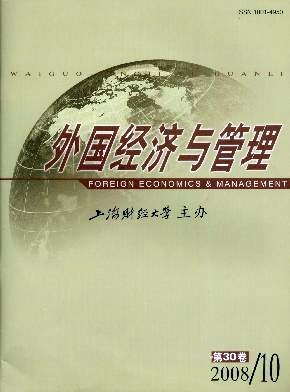高阶管理理论及其完善与拓展
外国经济与管理 2008 年 第 30 卷第 10 期, 页码:8 - 16
摘要
参考文献
摘要
本文在介绍高阶管理理论产生背景和基本观点的基础上,从个体和群体情境因素两个层面对高阶管理理论的理论框架进行了完善,并从深度和广度两个方面对该理论的研究对象和适用空间等进行了拓展,以期有助于提高该理论的有效性、企业高层管理的效能和企业绩效。
[1]Hambrick,D C,and Mason,P A.Upper echelons:The organization as a reflection of its top managers[J].Academy of Management Re-view,1984,9(2):193-206.
[2]Mintzberg,H,Raisinghani,D,and Theoret,A.The structure of unstructured decision processes[J].Administrative Science Quarterly,1976,21(2):246-275.
[3]Hannan,M T,and Freeman,J H.The population ecology of organizations[J].American Journal of Sociology,1977,82(5):929-964.
[4]Child,J.Organization structure,environments and performance:The role of strategic choice[J].Sociology,1972,6:1-22.
[5]Hambrick,D C.Upper echelons theory:An update[J].Academy of Management Review,2007,32(2):334-343.
[6]Eisenhardt,K M,and Schoonhoven,C B.Organizational growth:Linking founding team,strategy,environment,and growth among U Ssemiconductor ventures:1978-1988[J].Administrative Science Quarterly,1990,35(3):504-529.
[7]Carpenter,M A,and Fredrickson,J W.Top management teams,global strategic posture,and the moderating role of uncertainty[J].A-cademy of Management Journal,2001,44(3):533-545.
[8]Lieberson,S,and O’Connor,J F.Leadership and organizational performance:A study of large corporations[J].American SociologicalReview,1972,37(2):117-130.
[9]Hambrick,D C,and Finkelstein,S.Managerial discretion:A bridge between polar views of organizational outcomes[J].Research in Or-ganizational Behavior,1987,9:369-406.
[10]DiMaggio,P J,and Powell,W W.The iron cage revisited:Institutional isomorphism and collective rationality in organizational fields[J].American Sociological Review,1983,48(2):147-160.
[11]Hambrick,D C,Finkelstein,S,and Mooney,A.Executive job demands:New insights for explaining strategic decisions and leader be-haviors[J].Academy of Management Review,2005,30(3):472-491.
[12]Finkelstein,S.Power in top management teams:Dimensions,measurement,and validation[J].Academy of Management Journal,1992,35(3):505-538.
[13]Bantel,K,and Jackson,S.Top management and innovations in banking:Does the composition of the top team make a difference?[J].Strategic Management Journal,1989,10(S.I.):107-124.
[14]Tushman,M L.Approaches to organizations:A review and rationale[J].Academy of Management Review,1977,2(2):206-216.
[15]Lubatkin,M,Simsek,Z,Ling,Y,and Veiga,J F.Ambidexterity and performance on small-to-medium-sized firms:The pivotal role ofTMT behavioral integration[J].Journal of Management,2006,32(5):646-672.
[16]Lawrence,B S.The black box of organizational demography[J].Organization Science,1997,8(1):1-22.
[17]Cho,T S,and Hambrick,D C.Attention as the mediator between top management team characteristics and strategic change:The caseof airline deregulation[J].Organization Science,2006,17(4):453-469.
[18]Cannella,A A.Upper echelons:Donald Hambrick on executives and strategy[J].Academy of Management Executive,2001,15(3):36-44.
[19]Crossland,C,and Hambrick,D C.How national systems differ in their constraints on corporate executives:A study of CEO effects inthree countries[J].Strategic Management Journal,2007,28(8):767-789.
[20]Hambrick,D C,Finkelstein,S,Cho,T S,and Jackson,E M.Isomorphism in reverse:Institutional theory as an explanation for recentincreases in intra-industry heterogeneity and managerial discretion[J].Research in Organizational Behavior,2005,26:307-350.
[2]Mintzberg,H,Raisinghani,D,and Theoret,A.The structure of unstructured decision processes[J].Administrative Science Quarterly,1976,21(2):246-275.
[3]Hannan,M T,and Freeman,J H.The population ecology of organizations[J].American Journal of Sociology,1977,82(5):929-964.
[4]Child,J.Organization structure,environments and performance:The role of strategic choice[J].Sociology,1972,6:1-22.
[5]Hambrick,D C.Upper echelons theory:An update[J].Academy of Management Review,2007,32(2):334-343.
[6]Eisenhardt,K M,and Schoonhoven,C B.Organizational growth:Linking founding team,strategy,environment,and growth among U Ssemiconductor ventures:1978-1988[J].Administrative Science Quarterly,1990,35(3):504-529.
[7]Carpenter,M A,and Fredrickson,J W.Top management teams,global strategic posture,and the moderating role of uncertainty[J].A-cademy of Management Journal,2001,44(3):533-545.
[8]Lieberson,S,and O’Connor,J F.Leadership and organizational performance:A study of large corporations[J].American SociologicalReview,1972,37(2):117-130.
[9]Hambrick,D C,and Finkelstein,S.Managerial discretion:A bridge between polar views of organizational outcomes[J].Research in Or-ganizational Behavior,1987,9:369-406.
[10]DiMaggio,P J,and Powell,W W.The iron cage revisited:Institutional isomorphism and collective rationality in organizational fields[J].American Sociological Review,1983,48(2):147-160.
[11]Hambrick,D C,Finkelstein,S,and Mooney,A.Executive job demands:New insights for explaining strategic decisions and leader be-haviors[J].Academy of Management Review,2005,30(3):472-491.
[12]Finkelstein,S.Power in top management teams:Dimensions,measurement,and validation[J].Academy of Management Journal,1992,35(3):505-538.
[13]Bantel,K,and Jackson,S.Top management and innovations in banking:Does the composition of the top team make a difference?[J].Strategic Management Journal,1989,10(S.I.):107-124.
[14]Tushman,M L.Approaches to organizations:A review and rationale[J].Academy of Management Review,1977,2(2):206-216.
[15]Lubatkin,M,Simsek,Z,Ling,Y,and Veiga,J F.Ambidexterity and performance on small-to-medium-sized firms:The pivotal role ofTMT behavioral integration[J].Journal of Management,2006,32(5):646-672.
[16]Lawrence,B S.The black box of organizational demography[J].Organization Science,1997,8(1):1-22.
[17]Cho,T S,and Hambrick,D C.Attention as the mediator between top management team characteristics and strategic change:The caseof airline deregulation[J].Organization Science,2006,17(4):453-469.
[18]Cannella,A A.Upper echelons:Donald Hambrick on executives and strategy[J].Academy of Management Executive,2001,15(3):36-44.
[19]Crossland,C,and Hambrick,D C.How national systems differ in their constraints on corporate executives:A study of CEO effects inthree countries[J].Strategic Management Journal,2007,28(8):767-789.
[20]Hambrick,D C,Finkelstein,S,Cho,T S,and Jackson,E M.Isomorphism in reverse:Institutional theory as an explanation for recentincreases in intra-industry heterogeneity and managerial discretion[J].Research in Organizational Behavior,2005,26:307-350.
引用本文
李金早, 许晓明. 高阶管理理论及其完善与拓展[J]. 外国经济与管理, 2008, 30(10): 8–16.
导出参考文献,格式为:
上一篇:管理学人本主义范式评析





 9168
9168  876
876

